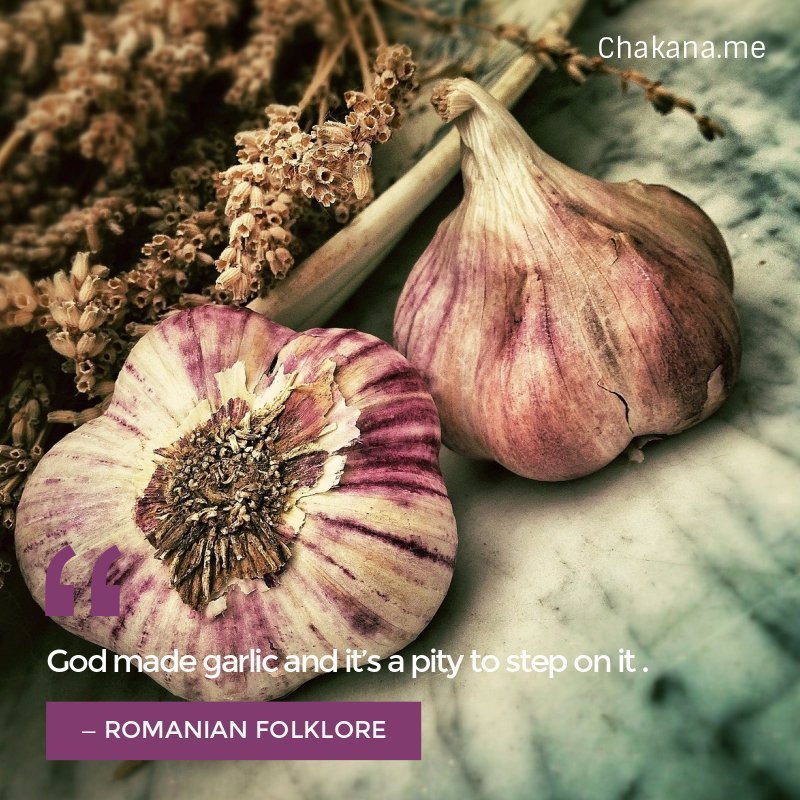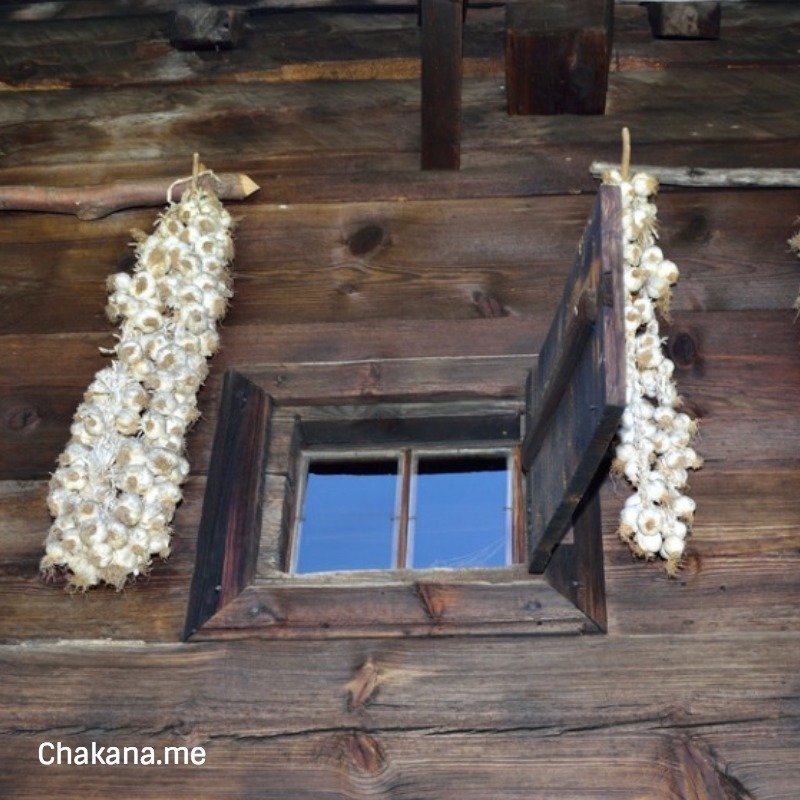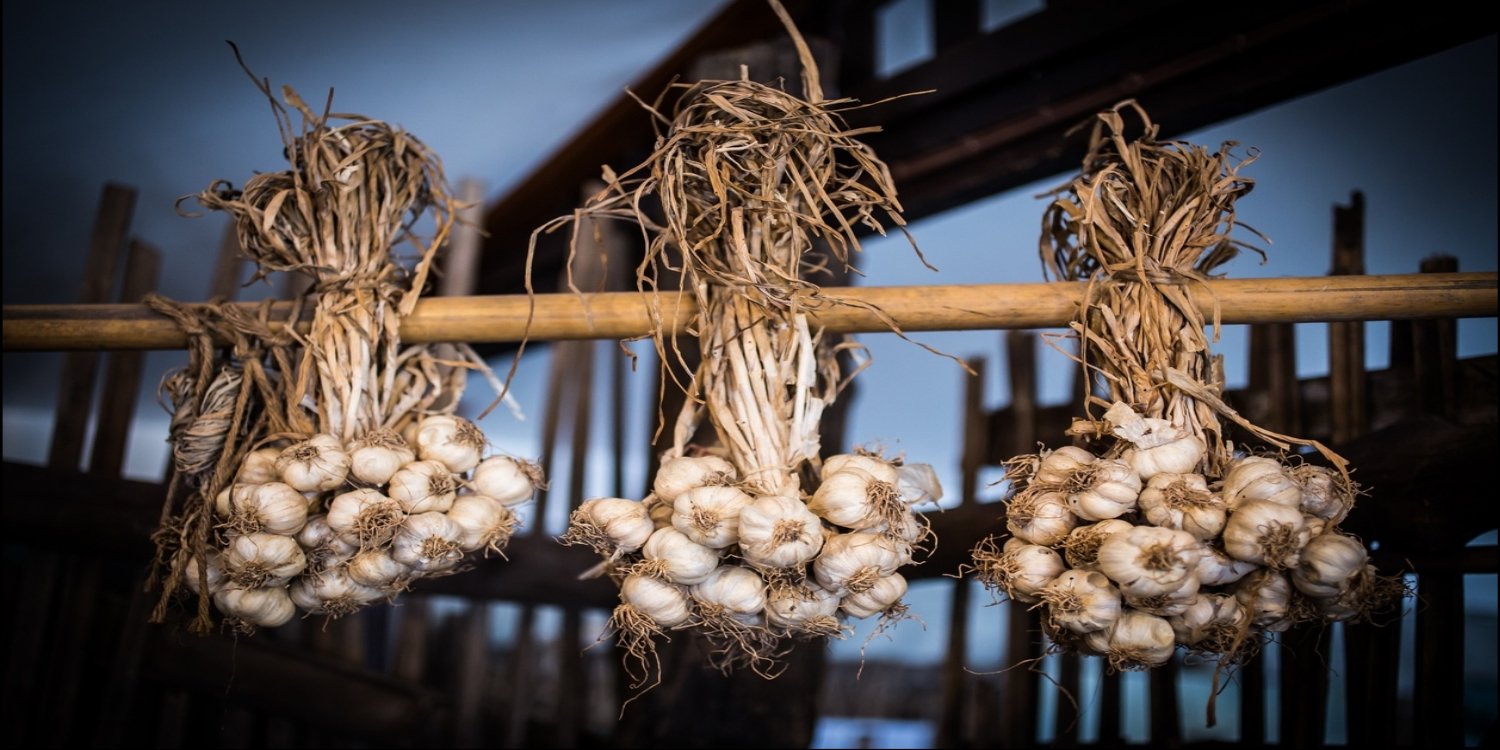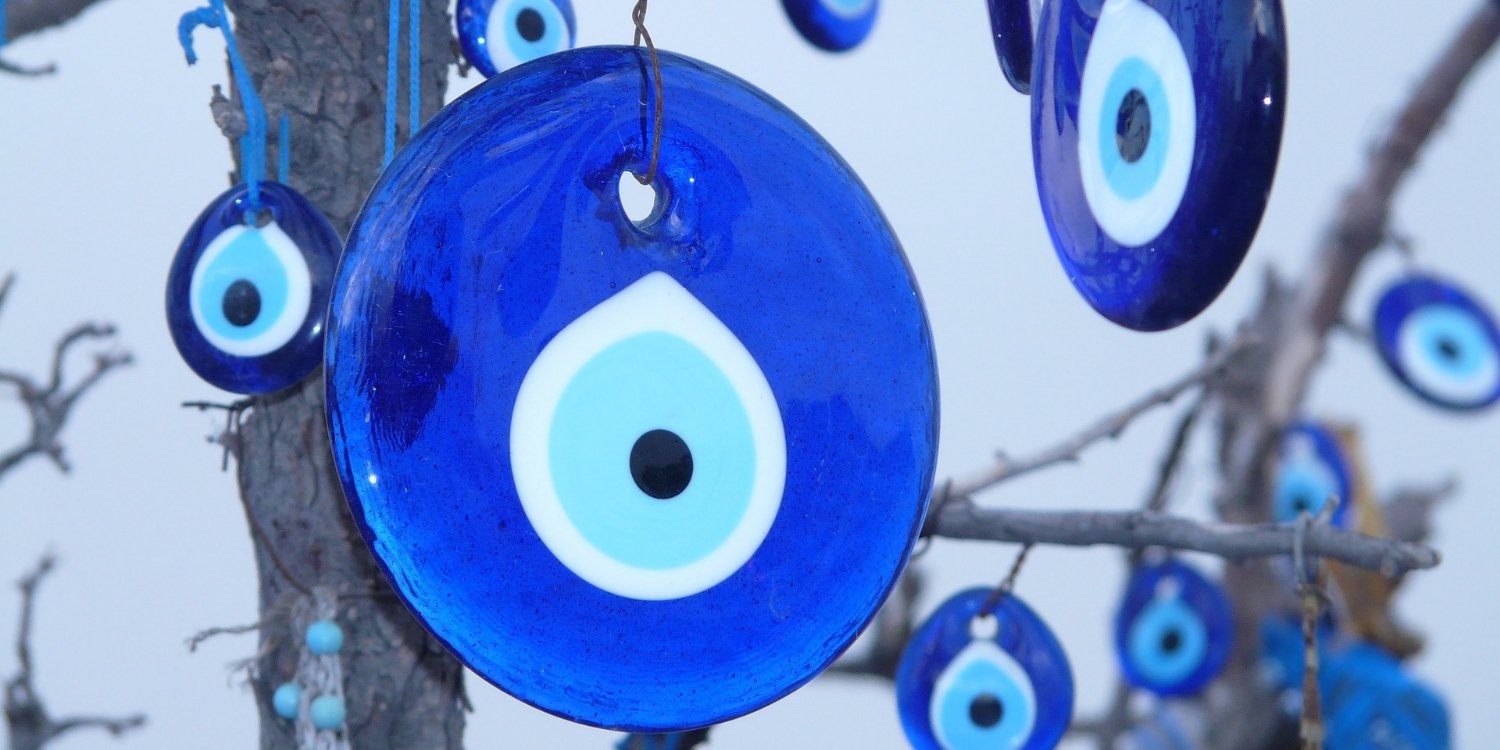Called everything from ”stinking rose”, “rustic cure-all”, “Russian penicillin”, “Bronx vanilla” to “Italian perfume“, garlic has been loved and despised throughout history for its taste and other mysterious properties. Garlic’s healing properties started a conversation thousands of years ago that still goes on. Though, the most fascinating stories surrounding the garlic have all to do with its magical attributes. This article tries to summarize the most important magical aspects as revealed by the Romanian folklore and traditions, while also taking into account what other cultures across the world have to say about it.
The birth of the garlic’s legend

The amazing world of folklore and mythology gives us a very different answer regarding garlic’s origin. In the Romanian folklore, garlic is not just a simple aromatic and medicinal plant. According to Elena Niculina Voronca, one of the most respected Romanian folklore experts, it is believed that “garlic is human; it has a head a cross, and it’s wears clothing”, and the garlic leaves are named “căței” (“puppies”). Garlic is a Christic plant as “it bears on it the sign of the cross”. It’s also a sacred plant: “God made garlic and it’s a pity to step on it. When you peel the garlic and throw the sheaths in the fire, don’t let them fall down.”
The Indian tradition gives garlic a sacred origin as it is said that it was born from a drop of amrita (divine ambrosia) unintentionally left behind by tired Garuda, a large bird-like creature, or humanoid bird that appears in both Hinduism and Buddhism. Garuda, Lord Vishnu’s vehicle, drives away evil spells, black magic influences, negative spirits and removes all poisonous effects in one’s body.
A Mohammedan legend states that when Satan left the Garden of Eden, garlic sprang from the place where his left foot stepped and onion from his right foot. The Bowers Manuscript, a fifth-century Buddhist medical treatise, includes a tale that says the first garlic appeared from the blood of a demon.
According to Pliny the Elder (23-79 AD), garlic and onions were invoked as deities by the ancient Egyptians at the taking of oaths. Archaeologists discovered clay garlic bulbs placed in Egyptian tombs with the dearly departed, yet they are unsure whether they were intended as funds for the afterlife or as idols to appease the gods.
Garlic – the vampire repellant

Although Bram Stoker’s novel, Dracula, had a lot to do with making famous Romania’s belief that garlic wards off the vampires, the truth looks a little bit different from this side of the world. With all due respect for those of you who think that garlic is just Romania’s vampire repellant, allow me to tell you that this is not quite accurate. Montague Summers, author of Vampires and Vampirism:
“Certain trees and herbs are hateful to him, the whitethorn (or buckthorn) as we have seen, and particularly garlic. Often when the Vampire is decapitated his mouth is stuffed full with garlic; garlic is scattered in and all over the coffin by handfuls; and he can do no harm. In China and among Malays to wet a child’s forehead with garlic is a sure protection against vampires.”
Obviously, there are numerous vampires, vampire-like creatures and all sorts of evil spirits present in worldwide mythology. Consequently, it’s not surprising that this far-reaching fears of such beings needed an all-mighty resource to ward them off, but …
“In truth garlic is not a universal deterrent; other common foods that can be used to thwart a vampire attack are poppy seeds, grains of rice, sesame seeds, iron shavings and peppercorns. Each of these items when thrown or left for a vampire to discover will compel it to stop and count each one. Ideally, this obsessive counting will take the monster all night, stalling it long enough for the sun to rise and destroy it; this is believed to be true of the Sucoyan of the West Indies.” (Theresa Bane)
Vampires – not a Romanian invention
It seems that term “vampire” appeared for the first time as “upir” (in Old Russian, 1047) in an old note written by a priest who transcribed a book of psalms. There he referred to “the evil upir”. It is also assumed that the word “upir” comes the Tatar word “ubyr” which means “witchcraft”. Another mention of the eleventh century goes back to Saint Gregory who talks about the pagan worship of the “upirs”.
Legendary healer Melampus and Theophrastus (c.371- c.287 BC) both suggested in their writings the Greeks’ belief that garlic protects people from witchcraft and vampires. Yet, if you go far much deeper and search the literature, you will realize that the term “vampire” was never actually used in the Antiquity’s texts. True, in the ancient texts across the world there are many references to supernatural creatures who feed on blood or human flesh. Vampires were presented as demons or malefic spirits. Here are just a few examples of such creatures that had vampire-like features:
-
- Vetalas and goddess Kali in the Indian mythology;
-
- Empusae, Lamia and Strix in Greek-Roman mythology;
-
- In the Scriptures of Delphi, a collection of myths and legends attributed to Babylon era, but gathered as a collection around 1700, there’s an entire chapter dedicated to vampires;
-
- Xortdan (Hortdan) is creature in the Azerbaijani mythology which raised from its grave and could transform in any kind of animal;
- The Vrykolakas or Kallinkantzaros have been in ancient Greek history for centuries.
Not just vampires, but also different evil spirits
The full list is extremely long, but, that does not mean, all evil creatures of the worldwide mythology qualify as vampires in the current definition of the word. Theresa Bane, the author of Encyclopedia of Vampire Mythology, also makes in her extremely documented book distinction between “vampires” (e.g. Agta, energy vampire in the Phillipines, Abchachu in Bolivia) and “vampiric spirits” (e.g. Chochonyi in Argentina, or Aipalookvik in Alaska, Greenland and Nothern Canada). As she also very well underlines, not all these creatures feed on blood and neither can be ward off only with garlic.
The Romanian mythology abounds in supernatural creatures. In his “Romanian Mythology” book, Tudor Pamfile talks about 46, out of which 37 (84%) are malefic creatures or evil spirits, while 8 % are benevolent and 8% neutral. Therefore, one can say that in the study of Romanian mythological supernatural beings, those with evil or malefic characteristics dominate.
Romanian ethnologist Romulus Vulcanescu, identifies few major categories of such creatures, namely “strigoi”, “moroi”, “pricolici”, “tricolici”. Their names are impossible to translate in English; the closest terms I would choose are ghosts, phantom or wraiths. It would not be accurate to say that they are the exact equivalent of what is generally understood as “vampire”.
Garlic – the ancient antidote for the evil spirits

According to Theophrastus, garlic was placed by the ancient Greeks on the piles of stones at crossroads, as a supper for Hecate, the goddess of magic, witchcraft, the night, moon, ghosts and necromancy. The reason behind this superstition is linked to the fact that the garlic placed at crossroads protects travellers from evil spirits and disorientates demons.
Montague Summers also mentions the use of garlic against evil spirits or witchcraft: “The West India negroes today smear themselves with garlic to neutralize the evil charms of witches and obeah men.” On the other hand, Buryat people of Mongolia believe that the presence of the women who died during birth, and who is known for coming back at night to torture the living, can be recognized by the garlic smell they spread around.
The Korean folklore mentions the garlic in the foundation myth of the ancient kingdom of Gojoseon, when eating of nothing but 20 cloves of garlic and a bundle of Korean mugwort for 100 days, let a bear be transformed into a woman. There are also mentions that eating garlic repels tigers while eating pickled garlic for those travelling dangerous mountain passes frequented by striped predators.
Romanian traditions
The ethnology and cultural studies report many customs and traditions related to garlic, yet most of them are related to specific areas, regions or villages across the Romanian land, so we cannot consider that they refer to the entire population. As in the case of other plants, popular traditions related to garlic’s magical powers are connected with some important religious celebrations (St.George’s Day, Pentecost, Saint Andrew’s Day, Christmas, New Year, etc), but not only. Garlic garlands are also seen around the houses even today.
Generally speaking, in Romania garlic is believed to be a magical plant which keeps safe people, animal stocks and households from dark or energies, evil spirits, ghosts, evil-eye and various diseases. Mainly on St.Andrew’s Day (November 30), Christmas (December 25) and New Year’s Eve locals use garlic juice to make a Christian cross sign on the door frames and locks, window frames, house eaves, stables and barns to protect themselves from evil spirits. Here are just a few examples I’ve found:
-
- In Transylvania it is said that those who eat garlic gloves on the eve of important religious celebrations (Christmas, Baptism of the Lord, Easter and others) will have nothing to worry about being bothered by the ghosts;
-
- To drive away ghosts you can ignite incense and garlic in a brass pot;
-
- In Moldova, on St. Andrew’s Day (November 30), there’s a traditional party where young people who are not married gather; in the meantime, one or two old women guard the garlic brought by the girls, so men won’t steal it; at sunrise, in some villages takes place what’s called Hora Usturoiului (The Garlic Dance); following this, they believe the garlic gets miraculous powers, meaning it’s good for healing; it is also believed that this garlic it’s good to be kept with them by travellers and while doing business or negotiations;
-
- When you are on a field and suddenly smell the garlic, it means there’s a snake nearby;
-
- In some regions of the country (e.g. Suceava, Valcea, Bihor), there’s a belief that if you lubricate the udder of the cows with garlic juice, they will give good milk the entire year;
-
- To protect the castles from being attacked or bitten by snakes or weasels, people in Olt country hang garlic yarns (threads) in the stables;
- In Hațeg county, people put garlic cloves in the dead’s coffin so it won’t turn into a ghost.
READ MORE: Garlic Stories
Initially, I wanted to give a short reply to BBC’s article Why Romanians are obsessed with garlic. That was my initial intention, but that’s how it turned out. I ended up with a series of articles is dedicated to the almighty garlic. All the things I found out while doing my research were far too fascinating, so I thought they worth sharing. So, you have several articles based on well-researched and selected information about garlic, vampires, myths and its medical use.
- The Almighty Garlic of the Ancients
- The Magical Garlic – Vampire Stories from All Over the World
- Romanian’s Garlic Customs and Traditions
Bibliography:
- Aggarwal, Bharat B. Mirodenii vindecatoare. Brasov: Adevar Divin, 2016. Print.
- Bane, Theresa. Encyclopedia of Vampire Mythology. McFarland, 2012. Kindle.
- Block, Eric. Garlic and Other Alliums: The Lore and The Science. Royal Society of Chemistry, 2015. Kindle.
- Chevalier, Jean & Gheerbrandt, Alain. Dictionar de simboluri. Bucuresti: Artemis, 1995. Print
- Ciausanu, Gh. F. Superstitiile poporului roman. In asemanare cu ale altor popoare vechi si noi. Bucuresti: Saeculum Vizual, 2014. Print.
- Cooper, Levi. World of the sages: garlic breath. 2008.
- Craznic, Oliviu. Despre strigoi si vampiri. 2011.
- Evseev, Ivan. Dictionar de magie, demonologie si mitologie romaneasca. Timisoara: Amacord, 1998. Print.
- Gorovei, Artur & Ciausanu, Gh.F. Credinte si superstitii romanesti. Bucuresti: Humanitas, 2013. Print.
- Greyduckgarlic.com. History of Garlic.
- Johns, Jason. Growing Garlic – A Complete Guide To Growing, Harvesting and Using Garlic. CreateSpace, 2017. Kindle.
- Pamfile, Tudor. Mitologie romaneasca. Bucuresti: All, 1997. Print.
- Porritt, Gwen. Garlic. 2007.
- Stanculescu, Catalin. Strigoi vii, morti, moroi si pricolici in mitologia romaneasca. 2017.
- Summers, Montague. Vampires and Vampirism. New York: Dover Occult, 2005. Kindle.
- Voronca, Niculita Elena. Datinile si credintele poporului roman adunate si asezate in ordine mitologica. Iasi: Polirom, 1998. Print.
- Vulcanescu, Mircea. Mitologie romana. Bucuresti: Editura Academiei, 1985. Print.








